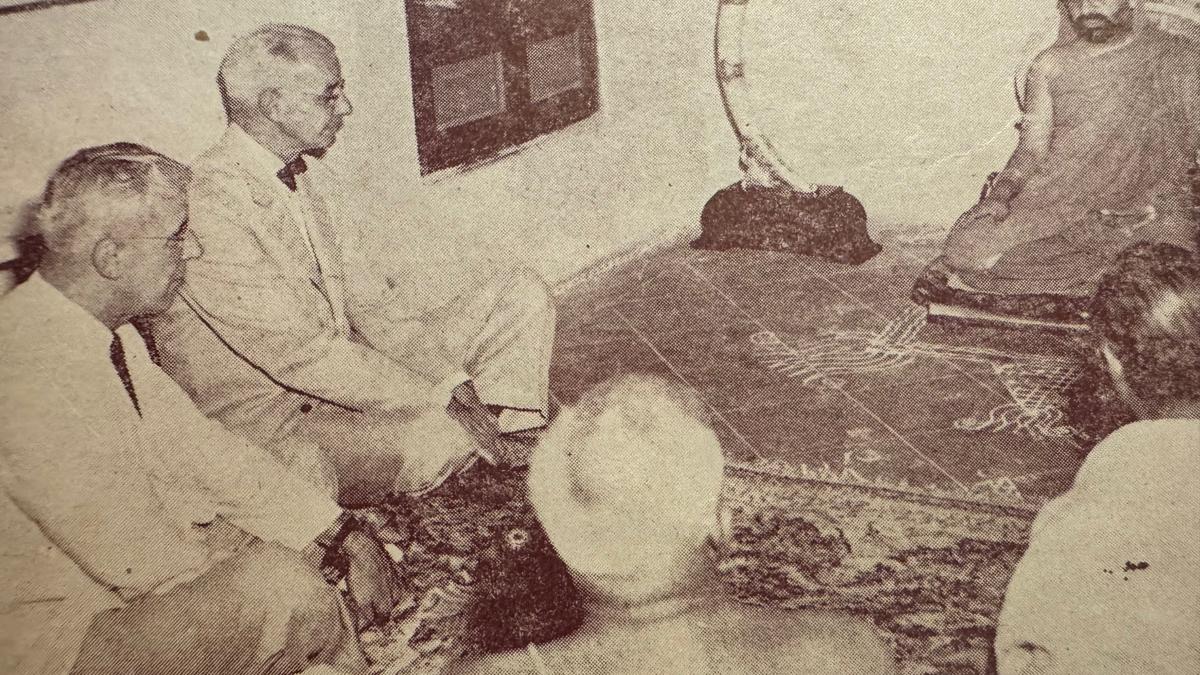
Looking at history books to trace the Madras-Sringeri connect
The Hindu
The history of Sringeri Sarada Peetham's visits to Chennai, from Vijayanagara times to modern industrial era.
Sri Vidhushekara Bharathi, the 37th pontiff of the Sringeri Sarada Peetham, a seat of learning that stretches back to Adi Sankara, is on a visit to Chennai. A history of visits to the city by various heads of the order is a fascinating record of how Madras has changed.
The land grant for Madras was made by the Damarla family in the name of their overlord, Venkata III, the penultimate Vijayanagara ruler. That great empire itself owed its origins to Madhava Vidyaranya, the 12th pontiff of the Sringeri order, who was the preceptor to the first kings, Harihara and Bukka. Even today, the ceiling of the Virupaksha temple in Hampi has a fresco of Vidyaranya being brought in a palanquin in procession to Vijayanagar.
Given its early associations with that kingdom, it is no surprise that Madras became a part of the itinerary of various heads of the Sringeri establishment. The book, The Saint of Sringeri in Sacred India (Dharmaprakash Press, Madras, 1969), has the details, although coupled with many sweeping assumptions and errors. The facts as far as I can see are as follows: The first visit was that of Abhinava Satchidananda Nrsimha Bharati (1741-1766).
This very likely would have been after the French occupation of Madras between 1746 and 1749. If so, it is possible that he camped in old Black Town, where the High Court stands today. Thereafter, owing to unsettled conditions in Mysore during the third Anglo-Mysore War, Satchidananda Bharati III (1770-1814) stayed in Madras in 1792. He made a second visit to the city in 1805. This was probably when the first building of the Sringeri order was built in the city, at Krishnappa Naicken Agraharam, off Mint Street. It survives even now, with some modernisation. A succeeding pontiff, Nrisimha Bharathi VIII, had a long tenure, from 1817 to 1879 and visited Madras in 1837 and 1870. He is recorded to have stayed on the Mutt premises, very likely the same structure described as being at Krishnappa Naicken Agraharam.
A fleeting record of a visit in 1885 by Satchidananda Sivabhinava Nrsimha Bharathi, the 33rd pontiff, occurs in the diary of the then Governor, ME Grant Duff: The Sringeri seers moved around in considerable state since at least Vijayanagara times and we note that this did not diminish during the British era. The Dewan of Mysore wrote to the Resident who in turn informed Governor Grant Duff of the retinue — elephants, camels, cows, horses, bullocks, palanquins, carts, coaches, swords, spears, muskets, and soldiers of the Mysore army. Thereafter, there were no visits till 1960, when Abhinava Vidyateertha, the 35th head, arrived. By then, Madras had changed. South Madras was the happening place.
While Krishnappa Naicken Agraharam was the first port of call, attention centred on Raja Annamalaipuram, T. Nagar, and Mambalam. Temples and offices of the monastic order were established in these places. The Acharya was taken on visits to many of the industrial establishments that were fast coming up in the city — the Integral Coach Factory and the transformer facility of Hackbridge-Hewittic and Easun being just two. And the welcome committee had several industrialists, led by S. Ananthramakrishnan of Amalgamations. While there were courtesy calls by erstwhile Maharajahs, what caught media attention was the arrival of Rajendra Prasad, President of India, and Ellsworth Bunker, U.S. Ambassador to India. In recent years, there have been many visits. The George Town branch has receded into the background. Sadly vanished are also two other landmarks associated with earlier visits — Vasantha Bungalow in Triplicane and Navasuja, that art deco masterpiece in R.A. Puram.
(V. Sriram is a writer and historian.)

While expressing happiness over the release of the pending 25% dues pertaining to bills for the completed civic works, contractors working under the Bruhat Bengaluru Mahanagara Palike (BBMP) termed the decision to withhold 5% as security against any defect found by Justice H.N. Nagamohan Das’ committee as unfair.

All India Kisan Sabha (AIKS) staged a demonstration in Thoothukudi against the Tamil Nadu government’s decision to classify agricultural lands owned by farmers in Keela Vilathikulam, Kathalampatti as temple assets, as well as to repeal the temple pattas of the lands which were taken from farmers of Vilvamarathupatti









